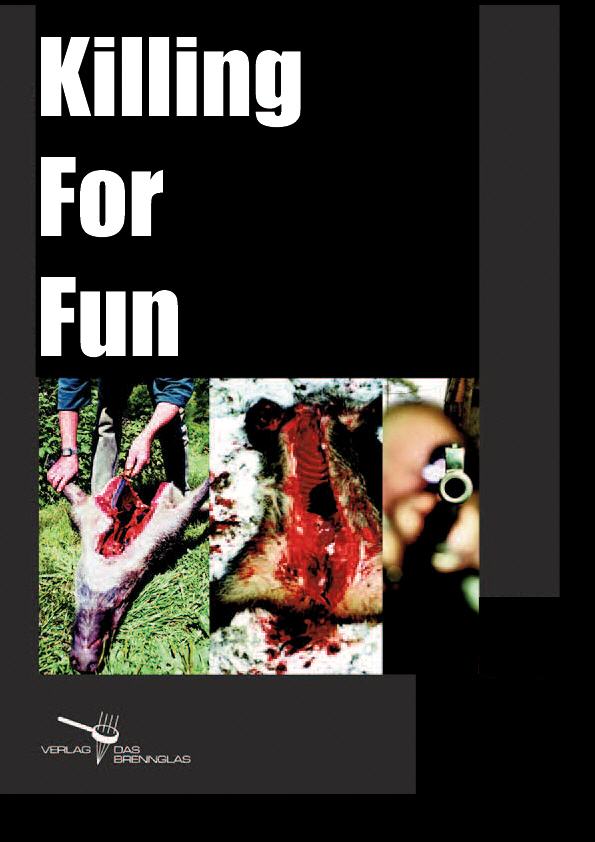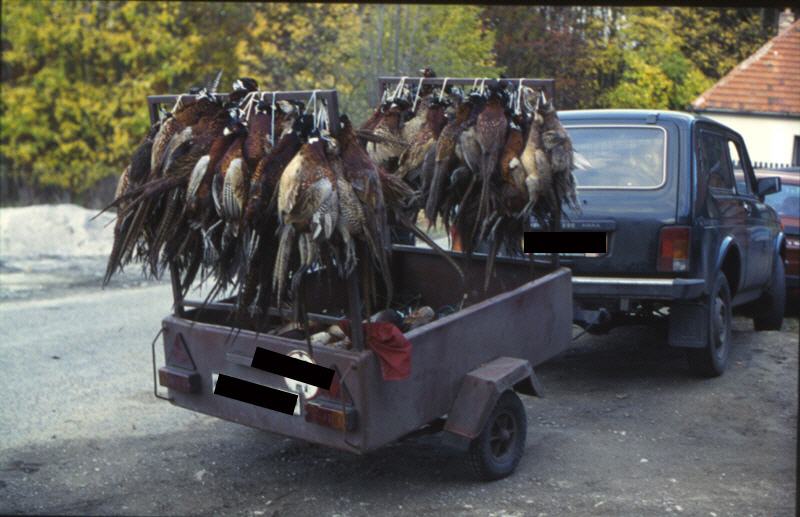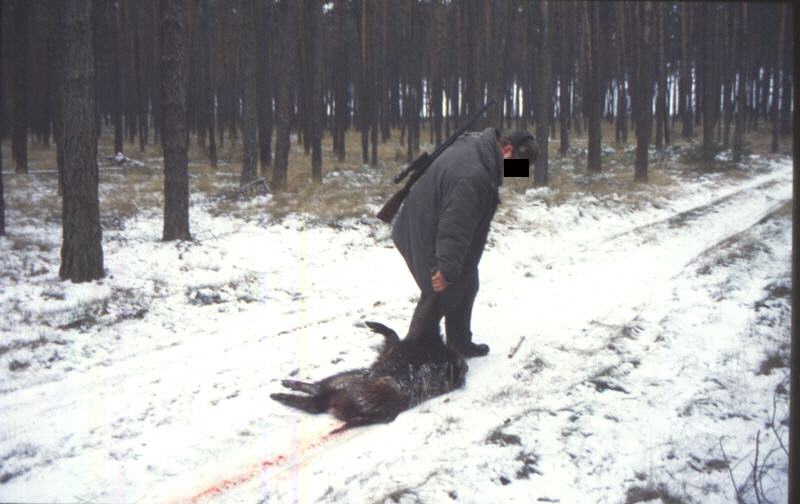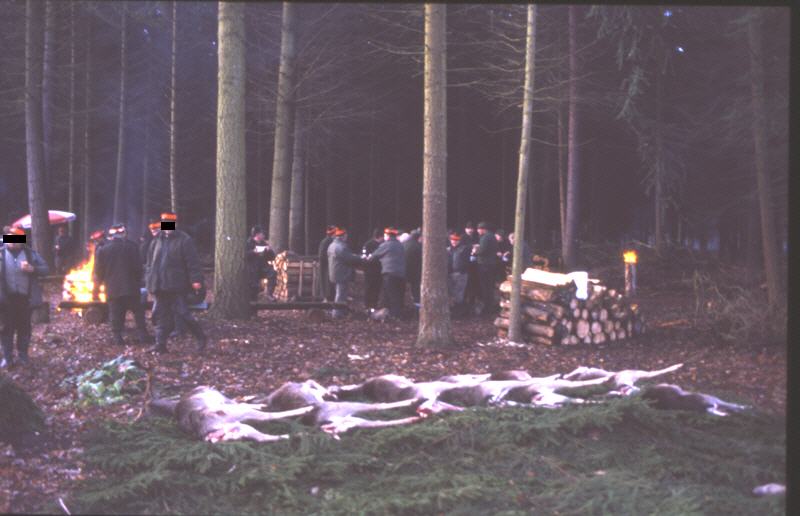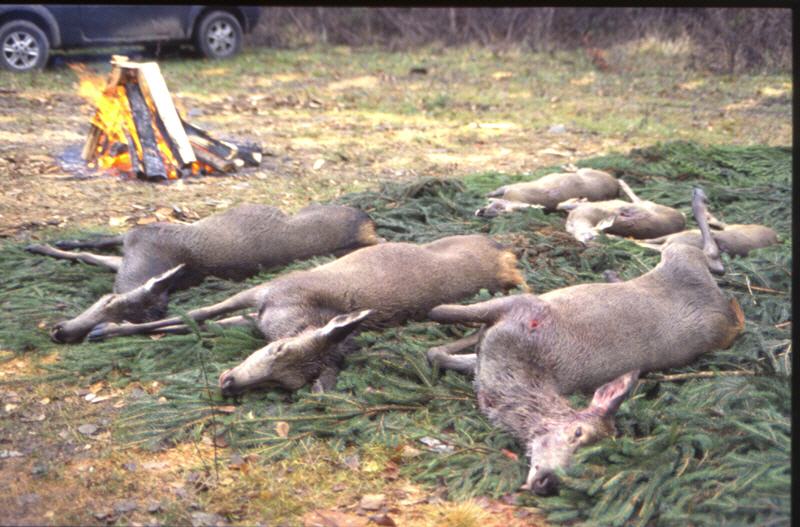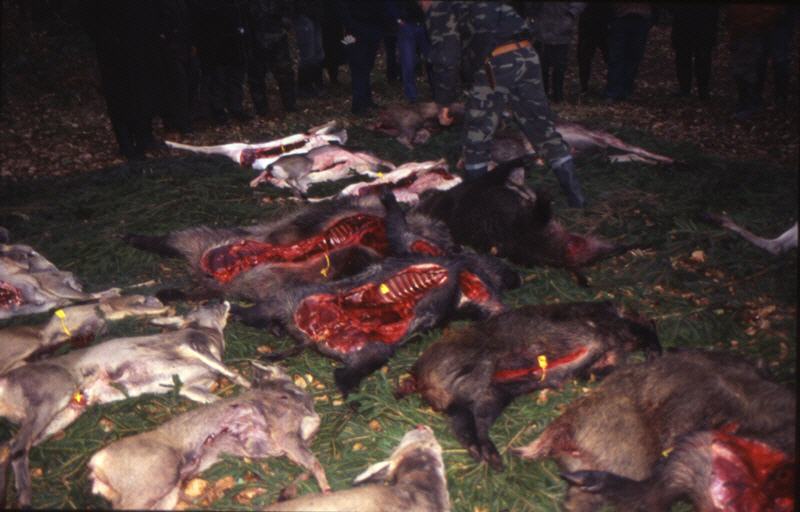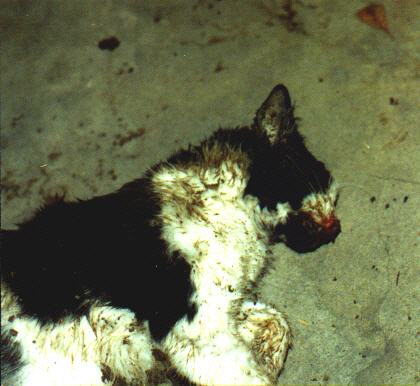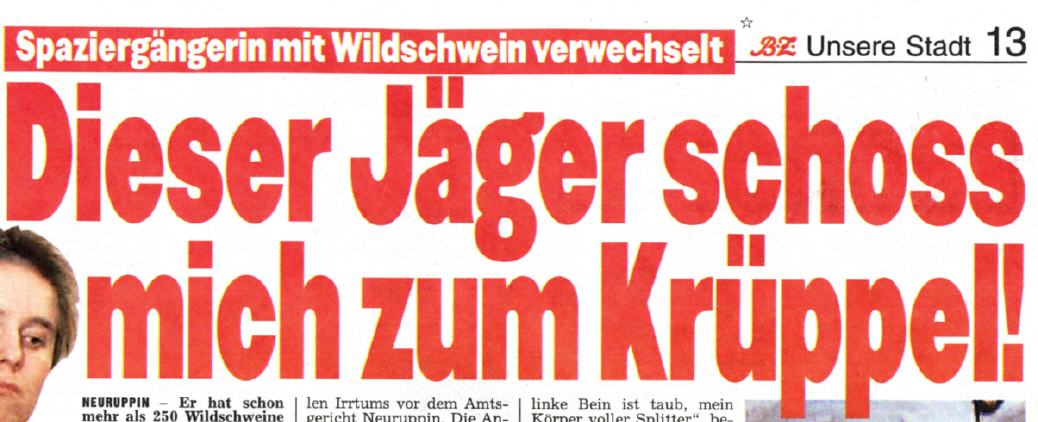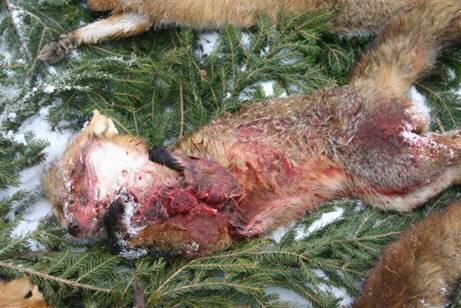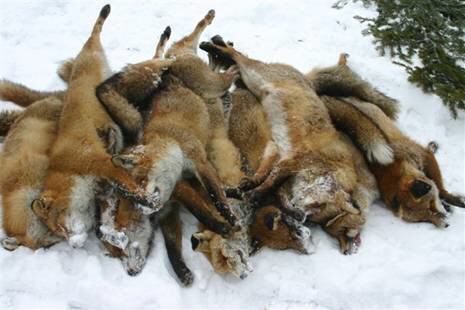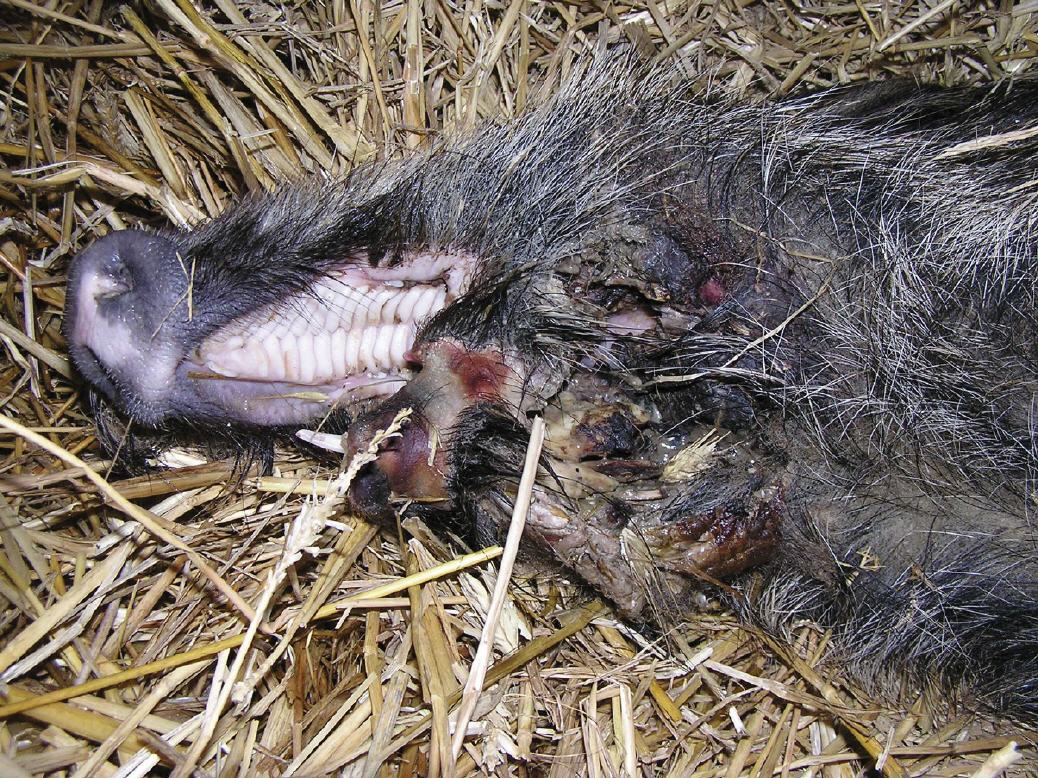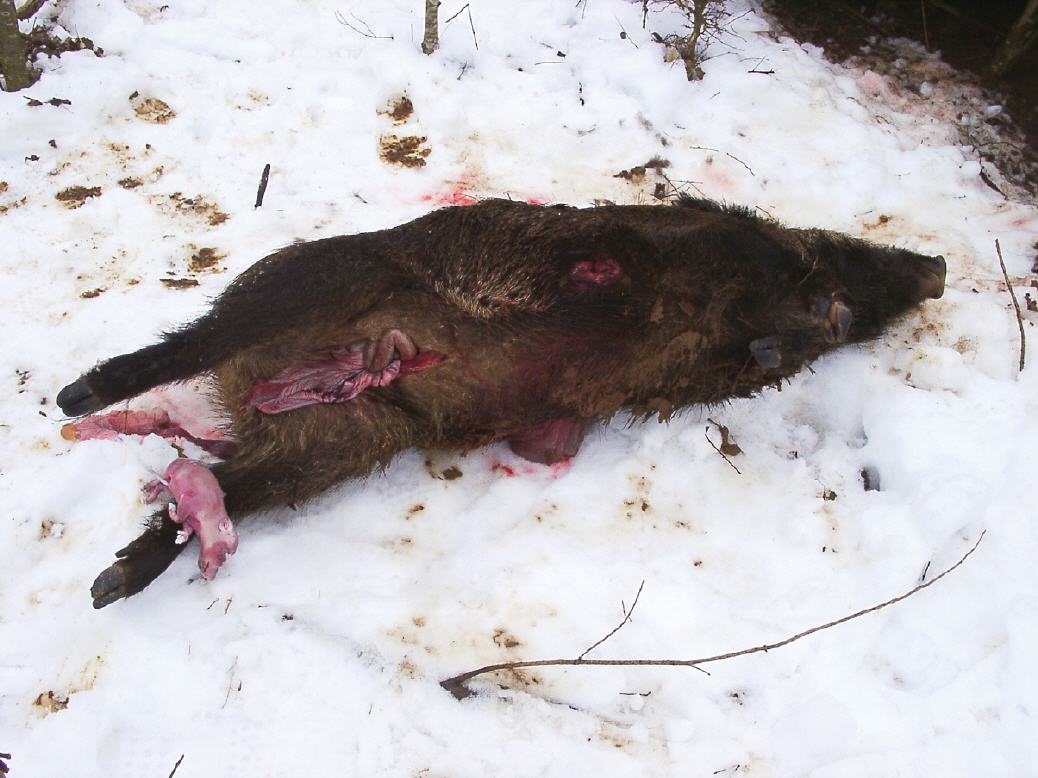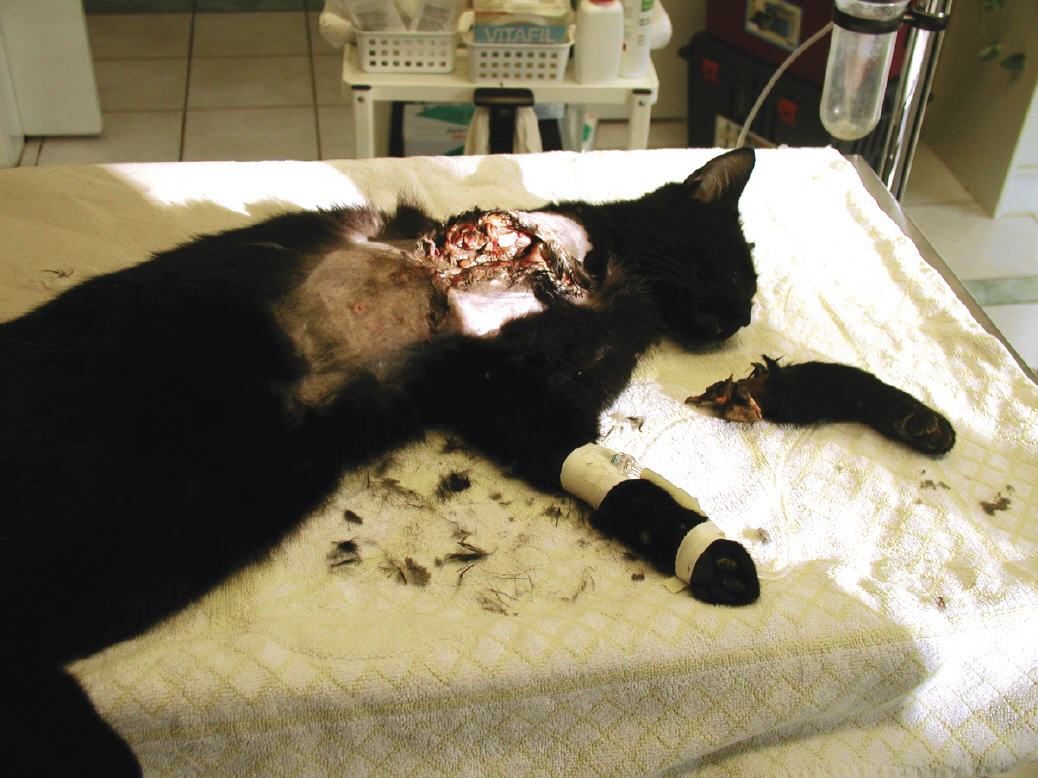Killing For Fun
pdf-download [3.978 KB]
Killing For Fun
Hunt – Most Germans are against it
A War Against Animals
These murders, expressed in numbers:
Every year 5,000 animals get shot, beaten to death, or snared in traps.
What´s more, yearly ca. 300,000 house cats and 35,000 dogs are killed during hunt or by huntmanship
Although the most still tenaciously disavow, it´s still bloody reality in the woods of Germany: 320,000 huntmen slay yearly not less than 5 Million animals. 5,000,000 animals – i.e. 13,700 every day, 570 per hour, nearly 10 animals per minute. Every 6 seconds, an animal is killed by a hunter.
A „quick death“ can in many cases by no means be talked of: wild pigs and deers often intentionally only get shot sore, so that „expansion bullets“ make blood and contents of the intestines of the seriously injured and flying animals spurt out as „stalk indicators“. The following search takes often many hours, during which the animal perishes in agony. Traps cause foxes and martens, but cats and dogs as well, an often torments for days on end – or make a cripple of them, e.g. foxes or cats with their legs missing.
The fairy tale about the huntmen/man as concervationist/s has long ago been confuted/disproved.
According to poll results, more than 2/3 of the German populace is sceptical about hunting or disapproves it. In a representative survey published in “Welt am Sonntag“, hunting was ranked 4th place of what Germans consider most urgently needed to be prohibited, following directly behind animal experiments, child pornography and the advertisement of tobacco product (according to “Komitee gegen den Vogelmord” - “Committee Against Killing Birds”, in 1999).
In 1996 the following was published in a study by “HÖRZU”: “71 % of all Germans (between 16 and 60) disapprove hunting” (source: HÖRZU 37/1999). In 2002, a representative survey even lead to following results: 68 % mean „The state should generally outlaw the hunting of feral animals as a leisure time activity,“ further 12 % support abolishing the hunt completely. 13 % would have the landowners decide to approve or not hunting on their estates. Merely 3 % claimed to be “fundamentally against a prohibition of hunting“
According to results by EMNID, September 10, 2003, 78 % perceive hobby hunting as bad. In 2004 this poll was repeated, the new results (presented on September 9) show: 76.3 % view hunting with discerning eyes or are even in favour of turning it down completely.
There has been a growing civil movement against the hunt. Since October 10, 2001, citizens from the entire country demonstrate to oppose to hunting in the capital, Berlin, and in major cities such as Munich, Frankfurt, Mainz, Dortmund, Hamburg or Hanover on every first Saturday in the month, demanding an end to the hunting. The federal “Initiative For The Abolishment Of Hunting” has made appeals on the internet for public demonstrations, and petitions for referenda (www.abschaffung-der-jagd.de). It has been a long time since criticism of the hunt has been taken up by the press and in the media as well.
The Hunt - Most Germans are against it
Representative polls by 'GEWIS' Insitute (from July 27, 2002) on the 'Attitude of the German Towards Hunting' show:
68 % think: „The state should generally outlaw the hunting of feral animals as a leisure time activity“
12 % stated: „I am in favour of completely abolishing hunting“
4 % declared: „I would support restriction of hunting in favour of animal welfare“
3 % said: „I am fundamentally against prohibition of hunting“
According to poll results by EMNID (from September 10, 2003):
78 % perceive hobby hunting as bad
81 % would forbid the hunting of migrant birds
77 % would favour a complete ban on lethal traps
65 % think that landowners ought to decide if hunting should be done on their estates
According to the opinion of 85 %, a targeting test should be repeated after every 3 years
Poll results by EMNID (September 9, 2004):
76.3 % view hunting with critical eyes or are in favour of turning it down completely
68.1 % find that the government should more strongly control the hunting in accordance with nature conservation and animal welfare
67.4 % would support the general prohibition of hunting by traps
80.4 would prohibit lead munitions
90 % would require a regular examination of the marksmanship proficiency of hunters
“In The Last 70 Years,
There Has Hardly Been Any Change In The Federal Game Law”
(Oberbayerisches Volksblatt - “Folk's Journey Of Upper Bavaria”, report on Horst Seehofer's speech at the Bavarian Hunters' Day, April 22, 2007)
It was in the year of 1934 that Herrmann Göring, “Superior Hunter of Adolf Hitler's German Reich“, issued the Game Law. In the western provinces of the Federal Republic of Germany the following Game Laws issued between 1949 and 1950 complied in their main features with that of the Nazis; the tradition of huntsmanship and the desire for trophy-taking has not been modified in the least (cp. Maylein, Klaus: “Jagd und Jäger in der modernen Gesellschaft - Ambivalenz und Notwendigkeit?” - „Hunting And Hunters In Modern Society - Ambivalence And Necessity?“)
That means that in German woods and valleys it's not the modern standards and criteria of animal welfare and integral nature preservation that apply, but hunting tradition from the times of Hitler's regime; and in the 21st century these old-fashioned ideas have no place. Extensive destruction of habitat, worldwide extinction of endangered species, as well as an up-to-date awareness on the part of the populace require different laws from those of 50, let alone 70 years ago.
These murders, expressed in numbers:
In Germany every year 5,000,000 animals get shot, beaten to death, or snared in traps.
What's more, yearly ca. 300,000 house cats and 35,000 dogs are killed during hunting
Every 6 seconds a feral animal is killed by a hunter.
Hunters Also Shoot At Domestic Animals
Every year, in Germany alone
ca. 300,000 cats and
ca. 40,000 dogs
are shot, beaten to death or trapped by hunters, in addition to horses, ponies, cows out to pasture, pot-bellied pigs, ducks tame to the hand…
Hunters Shoot At People Too
Every year about 40 people die from hunters using legal firearms.
Among them fellow colleagues and game beaters, but also wives and children of hunters, mountain bikers, people taking a walk, gathering herbs, children at play...
Lethal Shots
| Steinau (area Mainz/Kinzig). Local police suspect domestic quarrels to be the motive for a bloody crime, which took place on a public street of Steinau. A 33-year-old hobby-hunter shot his young wife first, and then himself too on Whit Monday. |
Killing Is The Hunter's Pleasure
In the German hunters' journal “Wild und Hund” (“Wild Animals and Hounds”), No. 24/2003, there is an article titled “Fear Not The Pleasure” (“Keine Angst vor der Lust”). It reports about a hunter's dissertation:
“At the very moment of killing the animal, hunters experience a kick, and they should come out of the closet and confess to it after all […] Most significant […] is that he himself (i.e. the hunter) is to die one day too. Certain about this one fact, he snuffs out the life of a game animal. By doing so, he provides himself with the sensation of being in control of nature and all its frightening certainty of death as well. So is the frequently criticized “pleasure of killing” - according to Kühnle - nothing else but a “devoted pursuit to overcome death by mastering nature” […] The hunter is not out for destroying a specific animal that he has been prowling and chasing, however, he cannot experience his emotional achievement, the kick, without having to annihilate the life of a special animal…”
At the Annual Convention Of The Forum For Vivid Hunters' Tradition, Prof. Dr. Gerd Rohmann, in his lecture titled “New Thoughts On The Pleasure Between Sensation And Slaying” describes the experience of the hunt. He speaks from the “pleasure by acquiring a prey” and points out that “the satisfaction of this kind of pursuit is not only strived by delight, it is also experienced during and after the act. We would like to describe this emotional process as delight and pleasure, respectively its activity character as passion.”
Rohmann also mentions the kick experienced in the process of killing: “Thus our killing a creature and experiencing an exorbidant effect of delight by doing so proves in an empirical way that we have special inner feeling… Hunting is similar to love: the most significant component of the erotic experience is also the journey. So the goal is therefore never a quick shot, but all the striving and desire, the sensation of a shared sustained climax. A common French metaphor “Le petite mort” refers to the sexual orgasm… The hunter experiences the emotional climax, the kick exactly in the moment, in which the mortal shot is triggered and also if the prey doesn't immediately receive the lethal blow and gets away…”
Quote From A Hunter:
“Hunting Opens An Avenue That Can Lead Either To Crimes Including Even Homicide Or To Sexual Lust”
“Hunting opens an avenue that can lead either to crimes including even homicide or to sexual lust” - this quotation is not from some animal-rights activist, but from a hunter himself: Paul Parin, prestigious neurologist, author and oft lauded psychoanalyst, and honorary doctor of the Klagenfurt University.
We non-hunters cannot judge if this statement is true or not. In any case, Parin writes in his book “The Passion Of The Hunter” about his passionate fervour, the fever of the hunt, following:
“Since my first hunting adventures I am convinced: hunting opens an avenue that can lead either to crimes including even homicide or to sexual lust, no matter when and where it takes place... Hunting cannot be up for grabs without pre-meditated killing. Passionate hunters want to kill. Hunting without murdering would be an expression that would annul itself… For it is all about passion, greed, lust - a fever actually - […], sex and crime, lust and crime, death and sexual murder.”
(Parin, Paul: “Die Leidenschaft des Jägers” - “The Passion Of The Hunter”, 2003).
Responsible fellow citizens will have a sense to judge whether these actions are desirable or not.
No Hunters Needed!
Hunters´ Lie No.1:
“Hunters Protect The Forest From Damage Caused By Game Foraging”
WRONG!!!!
On the contrary: hunting virtually provokes significant damage caused by game animals. For example, deer inherently live in the grassland-meadows and the outskirts of the wood. The hunter is the one who forces game animals back into the forest, where they - not finding the essential the grasses and herbs - begin to nibble buds. The hunt startles the animals unnecessarily, which causes an increase in their nutrition needs and so increase the damages done as well. The popular argument that animals cause damages is no more than the poor excuse of hunters to obtain longer hunting seasons and more allowable kills. Most often the damages caused by hunters are greater than the agricultural damage caused by game animals.
As the standard work “About The Nonsense Called Hunting” by the zoologist Carlo Consiglio at the University Of Rom plausibly demonstrates, damages from overgrazing game are mostly minimal, and they only consume less than 2 % of the flora. Besides several specific methods such as fences or nets can provide additional protection. A study by the Minister For Agriculture in Brussels points out that damages by animals could be almost completely prevented, if the feeding were extended for the whole year” (Ueckermann: “Einfluss der Fütterung auf den Schälumfang des Rotwildes” - “The Influence Of Extensive Feeding On The Red-Deer Population”, 1985). Finally, the administration could compensate for it, as is common in cases where damages result from military maneuvers during field exercises.
In areas where no hunting is allowed (e.g. in the national parks of Switzerland - free of any hunting activities for over 100 years!), a continuous forest-growth is observed!
Damages by game foraging occurs because animals aren't left any harvest remainders:
- Earlier, at harvest times, many grains fell down and potatoes were left in the soil. A little always remained in the field for the animals.
Nowadays, nothing stays behind. Up-to-date machines leave nothing behind - every single kernel is literally taken away from the animals.
- Earlier, wild game could graze at farm lands, in the meadows and fallows.
Nowadays, natural occurring meadows have also become subject of intensive agricultural use, natural forest edges have disappeared and there aren't many farm lands left.
- Earlier, meadows were naturally farmed.
Nowadays, they are all poisoned by chemicals, different fertilizers, as well as garbage and liquid manures - not a single herb survives. This generates the decrease or even extinction of threatened species, as that of the wild hares.
Modern agriculture has taken away the food source of the animals. The hunter “regulates” the imbalance: if wild animals venture into the fields foraging for food, they get picked off. Their habitat has been noticeably constricted in the last decades; the cause are - once again - the humans. Could it not be regarded as a task of mankind to return to the animals their living space?
Hunters´ Lie No. 2:
“Hunters Replace Extinct Predators”
WRONG!!!!
Research proves that it is not the predators that are responsible for the regulation (i.e. population control) of their prey. They primarily feed on old, sick or weak animals, eat carrions, and therefore make a contribution to a healthy wild animal population. A hunter, shooting from great distance, can hardly judge if an animal is sick or old. In fact, since hunters are mostly out for magnificent specimens (namely those with trophies), the hunting as a rule leads to a counter-selection. In a hunter's words: “hunting also means to kill not only sick and old animals, but also “surplus” ones in robust health as well (who wants to eat cripples and sick animals?).” (Wild und Hund 13/2001).
Wolves, lynxes and brown bears are virtually exterminated, eagles are strongly decimated - and the return of these rare species (as seen with the example of bear Bruno) is not likely. By shooting yearly around 700,000 martens, foxes and weasels, hunters decimate additionally these predators that have not yet disappeared - with the schizophrenic explanation that they eat the hunters out of their prey. So that hunters have enough to shoot at, deers, stags and wild pigs are in a legal or illegal way massively feed in order to lure them to the raised hide-aways. According to research of the “Wildforschungsstelle Aulendorf” (“Wild Research Institute Aulendorf”, Baden-Württemberg), the ratio is 250-300 kg corn spread out in the forest per one single animal killed.
Hunters´ Lie No. 3:
“Hunting Is Applied Nature Conservation”
WRONG!!!!
Hunting is a disturbance of the natural eco-systems' balance. It can induce the decrease of animal species, or even their total extermination. Hunters are users of nature, no conservationists of it. They take care only of those species that are of use to them. And they contradict themselves too: “hunting as applied nature conservation” or “hunters as the just conservationists” etc. - all nice! Yet we are not accepted by the conservationist organizations. Why don't we just go ahead and confess to our actual purposes? […]) Hunting is primarily nothing else but getting prey, that's what we want, isn't it? There´s nothing objectable about feeling pleasure when we slay an animal. No, it may absolutely provide us with pleasure, and why not enjoy terminating it by a clean shot… (Wild und Hund 13/2001)
In 1975, the people of the Swiss canton Geneva adjudicated by a referendum upon a highly acclaimed general prohibition of hunting for mammals and birds. In the following the number of the birds over-wintering at the coasts of the Geneva Sea and at the Rhone increased spectacularly - no doubt as a result of the absence of the disturbance from outside. Before the referendum came into force, hunter representatives claimed that, without hunting, hares would be threatened to become extinct by predators. It turned out to be the very opposite case: in the meanwhile Geneva canton enjoys a healthy and augmentable hare population, the greatest in Switzerland. The fear of the farmers that the prohibition could cause damages, proved false: they are comparable with those in Schaffhausen - although there hunting is permitted.
Many species that are still fair game (hares, pine marten, woodcock, grey partridge) are on the red list of threatened species. Hunting is not always the only endangerment for them , however, it surely doesn't contribute to their preservation. Since the 17th century, hunting and the deconstruction of habitat are responsible for the extinction of 57 % of diverse bird species and that of 67 % of the mammals.
In addition to it, hunters blow out (only in Germany!) 1,500 tons of highly poisonous lead into the environment. This generates the accumulation of heavy metals in food chains. It's definitely no applied conservation but applied toxication.
Hunters´ Lie No. 4:
“Without Hunting Animals Would Over-Abound”
WRONG!!!!
Field studies carried out by ecologists showed that animals do have an inner mechanism to regulate their population-growth: this regulation is not a result of the hunting. In case of threatening by excessive increase, birth-rate simply gets reduced. No such overpopulation was detected till now in European areas either, where hunting is forbidden, such as the vast Italian National Park, the Swiss National Park or the Canton of Geneva. In nearly all nature sanctuaries hunting is prohibited, nowhere, without the balance even slightly derailed out of control…
Hunters´ Lie No. 5:
“Hunters Kill Painless”
WRONG!!!!
In many cases animals merely get wounded, the trailing, provided that it takes place at all, may last for hours or days, during which the shot wild game on the run drags itself through the forest with lacerated body, fractures, and the innards spilling out of them. Shot often also only wounds animals, especially wild birds that get only injured and therefore don't die immediately, since no vital parts may be hit. They often perish not until many hours or days have passed. Every fourth wild duck lives with a shot wound.
The most barbarous kind of hunting is that by traps. Lethal traps are still permitted - the animal snared in them is seldom dead right away. In box traps that are intended to catch animals intact, they usually get into panic once the box is closed with a huge crash. They move around fiercely and injure themselves badly. The “head” (hunter's jargon) thus lies in blood, tormented by terrible pains, not unusually starving and thirsting for hours or days in a narrow box to await a horrid death.
Hunters' Lie No. 6:
“Hunters Protect People From Rabies”
WRONG!!!!
In Europe a downright campaign for the annihilation of the foxes is being undertaken: shot, gin traps, conventional traps, gasification in their dens, impoisoned baits are only some of the methods in use - and in fact perennially. However, the spread of rabies has not been stopped by these measures. By vaccination, Wallis Canton (Switzerland) has been free of rabies since 1981. This campaign cost 106,800 for every year, while in Bern, the adjacent canton of only slightly greater area, 818,148 for were spent for killing foxes and the inoculation of the livestock cattle, without having even the slightest success in the containment of the dispersion of rabies.
Incidentally, the probability of getting infected by rabies in Germany is 1 : 171,875,000 (Horst Hagen, 1984).
Hunters' Lie No. 7:
“Hunt Is Part Of Cultural Assets”
WRONG!!!!
By culture/Culture includes, “the intellectual and artistic manifestation of life […] of a certain folk in its entirety”, as well as “a fine way of life and education” is meant (cp. Duden, vol. 5, 1982). Whether killing wild animals is one of these? - Certainly not!
People's presuming to kill creatures that feel and sense pain for pleasure is from a moral point of view unacceptable.
Hunters' Lie No. 8:
”Humans Have Always Done Hunting”
WRONG!!!!
In early civilizations humans used to be gatherers. The patterns due to wear-out on the molars of hominids, these ancestors of the Homo sapiens, is the evidence/result from eating/that they were herbivores eating vegetable fibers, fruits with hard paring, different nuts etc. Typical carnivores (such as wolves, lion) and omnivores (e.g. shrew, hedgehog) possess dental and adamantine/ enamel structures of the molars and differing from those to be found in today's humans.
This early-stage vegetarianism is reflected in the bible as God says/announces in (Genesis 1:29): “Behold, I have given you every herb yielding seed, which is upon the face of all the earth, and every tree, in which is the fruit of a tree yielding seed; to you it shall be for food.”
However, in the very same extent humans began to wage war against their own siblings, have they begun to slaughter animals. The hunting done by “primitive” folks serves the food supply. In Europe people no longer go hunting in order to secure food. It has become solely a leisure time activity, for the amusement - to take pleasure in killing. Hunting is the bloody hobby of a minority: hunters represent not more than 0.3 % of the population - the very most of which are hobby-hunters.
80 % of the German are against hobby-huntsmen. More and more people recognize: animals have the right to live. They feel similar to us - joy but also sorrow. It is condemnable to kill animals out of base motives!
Scientific studies show that hunting harms the nature and affect the ecological balance in our woods. It's high time for the legislation in Germany finally to be adapted to the current level of knowledge and the will of the majority.
Since 2002 animal protection is part of the constitution and raised to national objective. Hunting is no longer up-to-date!
Theodor Heuss, who, as the first president of the Federal Republic of Germany frequently had to participate on hunts organized for diplomats, said in a felicitously: “Hunt is nothing more than the coward circumscription of particularly coward murder of fellow creature that has not the slightest chance. It is variant of a mental disease”.
“Huntsman´s passion”, which hunters are so proud of, is a dangerous perversion! Leo Tolstoi said: “It is merely a single step from killing animals to homicide!”
|
“From Killing Animals To Homicide Is Merely One Single Step!” (Leo Tolstoi) |
|
“But Hunting Is Still A Form Of War” (Johann Wolfgang von Goethe) |
The consequences of hunting are not only reflected in the way animals die, but it destroys their families and social collectives as well. It drives them away from their familiar domiciles and resting places. This causes accustomed processes and exchanges to fail, and triggers completely non-typical migrations. It forces them into a permanent state of alert, fear, and terror, and drives them neurotic.
It can go as far as that: an intelligent animal (such as a deer or a wild pig), flees from hunters and runs to a main road into the front of a car. Hunting can turn the natural balance upside down: animals suddenly bear their children in the late autumn or winter. Birth rate escalates in order to counterbalance the decimation by hunters.
The so-called closed season is to make it possible for wild animals to give birth to their offspring - for this is essential for the joys of hunting after all.
Painful agonizing distressful excruciating harrowingly dolorous torturous Death In Traps
Traps belong to the most widespread methods of hunting for foxes and martens. They are required by law to either “instantly kill” the animal or “capture it intact”. In reality, however, they are “downright instruments for torturing animals” (Frommhold, Dag: Informationen Zur Jagd - “Information On Hunting”).
As for a “Safe-Catch Box Trap”, according to study results, the animal usually gets into panic immediately as the box is closed with a huge crash, they move around wildly and often injure themselves badly. The victim thus lies starving and thirsting for hours or days on end, tormented by terrible pains to await death.
As for the idea that instant-killing traps can be guaranteed to kill the animal immediately, if, for instance, a marten gets caught in a - for its size - far too large fox-trap, it gets seriously injured, but not killed right away. Raccoons and foxes tend to try to snatch the bait with their paw, and are made into cripples. If the trap slams on the paw of an animal, it regularly happens that the animal in desperation - in order to escape - chews its way out by biting its own leg off the steel bails. In hunters´ jargon this is called: “the fox has cut and run” or “cut out”.
Of ca. 650 foxes - 1/4 of which had been caught in, 7 % of them had an old leg injury (cp. Frimmhold, Dag: Keine Gnade für Füchse - “No Mercy for Foxes”, p. 344). But even birds of prey, such as buzzards and ospreys become victims of regular and spring traps.

